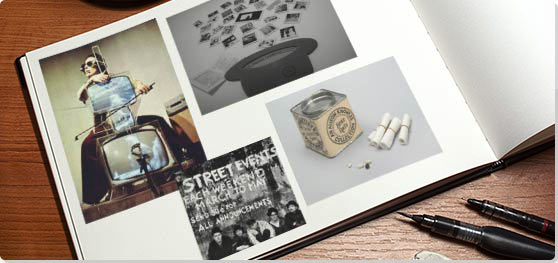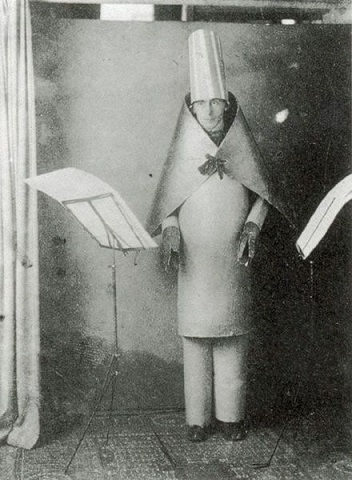Summary of Fluxus
Emerging in the 1960s and operating globally, Fluxus was an interdisciplinary and experimental approach to art that emphasized blending different artistic media and breaking down traditional boundaries between art and everyday life. Fluxus artists encouraged a playful and open-minded approach to art-making, creating a wide range of unconventional works, often using ordinary objects and actions to challenge traditional notions of art and engage audiences in interactive experiences. George Maciunas, the primary founder and organizer of the movement, described Fluxus as, "a fusion of Spike Jones, gags, games, Vaudeville, Cage and Duchamp".
While the vast majority of Fluxus artists conformed to some, if not all, of the main themes of the movement, many held contrasting ideals and different individuals viewed Fluxus in different ways, leading to significant variation. As filmmaker George Brecht stated, "In Fluxus there has never been any attempt to agree on aims or methods; individuals with something unnamable in common have simply coalesced to publish and perform their work." For some Fluxus artists, even the act of defining the movement was seen as restrictive and counterproductive to the spirit of their work. By resisting a clear definition, they maintained a commitment to challenging established norms and fostering a creative environment. This makes Fluxus difficult to define and some debate exists around which artists should be included in the movement.
Key Ideas & Accomplishments
- Unlike traditional art movements that compartmentalized different forms of artistic expression, Fluxus sought to break down these barriers and create a more interconnected and immersive artistic experience, integrating visual arts and literature with performance-based media including music, dance and theatre. In emphasizing elements of performance, they also legitimized the medium within artistic circles.
- Like the Futurists and Dadaists before them, Fluxus artists did not agree with the authority of museums to determine the value of art and they believed art was not only for the educated elite. Fluxus artists worked to dismiss and mock the elitist world of "high art" and to find ways to bring art to the masses through approachable artworks and the use of humor. Their irreverence for "high art" had an impact on the perceived authority of the museum to determine what, and who, constituted art and helped to change the balance of power in the art world.
- Fluxus works often relied on the element of chance to shape the ultimate outcome of the piece and one of the main ways this was achieved was through audience participation in artworks. This approach reflected a rejection of rigid artistic control and fostered a more interactive and open-ended experience, reflecting a broader, more inclusive approach to creativity.
Artworks and Artists of Fluxus
Make a Salad (1962)
In Make a Salad, Knowles prepares and dresses a huge salad while live music plays. She responds to the music, chopping vegetables in time to the beat and includes elements of theatricality, tossing the ingredients in the air. The salad is then served to the audience, integrating them as co-creators in the piece. The emphasis is placed on the process of making and consuming the salad rather than any physical output, with Knowles commenting that she was interested in exploring the processes of "everyone, eating, not only together but...the same thing”. The piece consequently comments on ideas of community, creating a shared experience that fosters connections between individuals engaged in the work.
By turning the preparation of a salad into an art form, Knowles challenged the conventional notions of what constitutes art, elevating a mundane activity to the realm of artistic expression. By choosing a domestic and traditionally feminine process as the subject, Knowles also challenged gender stereotypes and raised questions about the hierarchy of artistic mediums and subjects.
Knowles first debuted the work at a Fluxus concert held at London’s Institute of Contemporary Arts and it has been performed at a number of venues since. The inspiration for the performance came to Knowles when she was asked what she would be presenting at the ICA event and she replied "Well, maybe I'll make a salad".
The repetitive, nearly meditative actions of the performer, mark this piece as drawing from the more Zen-influenced aspects of Fluxus practice. Knowles creates an experience that resonates with Zen principles of mindfulness, impermanence, collaboration, and simplicity. The artwork becomes a moment of shared contemplation and a celebration of the beauty inherent in everyday activities.
Performance - Various locations
Licking Piece (1964)
Also known as Lick Piece, the directions for Patterson's work state, "cover shapely female with whipped cream, lick, topping of chopped nuts and cherries is optional." The piece was initially performed on May 9, 1964, at Maciunas’ Fluxhall in New York City with Letty Eisenhauer as the unclothed woman who was licked by a number of co-performers, including Patterson.
With this work, Patterson wrestles with themes of eroticism, objectification and misogyny. He reduces the participants to instruments of sensory experience, highlighting the power dynamics at play, where one person's body becomes the canvas for another's actions. The specification that a “shapely” woman is the subject reinforces traditional gender roles and expectations and while the performance was consensual, it still places women in a submissive or passive role. The subsequent discomfort surrounding Licking Piece reflect the complex and often contentious nature of performance art that involves the human body and interpersonal dynamics.
As a black artist, Patterson also touches on issues of race in the work. As cultural theorist Fred Moten writes, “the display of a black man licking whipped cream off a white woman (only later would the piece be performed with women of color) produces the oblique view that acknowledges the open secret of our subjugated bodies, the one female in the performance and the one black man exposing the deeper mechanics of the normative relationship between the clothed and the nude, the black and the white, the male and the female.”
Performance - Various locations
Zen for Film (1964-65)
Zen for Film is an eight-minute silent film showing nothing but a white screen with occasional scratches and graininess. Paik strips away the standard elements of a film such as narrative, characters, and traditional visuals, and leaves only the technical components. By reducing the visual content to its most basic form, Paik emphasizes the essential nature of film as a medium of time, light, and space.
In this way, Paik explores concepts of minimalism by presenting an absence of visual and auditory stimuli. The silence and emptiness challenge conventional expectations of what a film should be, prompting viewers to engage in a contemplative and participatory experience and to reflect on the nature of cinema and perception. Like the work of Cage, Paik's piece reflects the Zen philosophy of simplicity, mindfulness, and the appreciation of the present moment and this is reflected in the title of the piece. By reducing the film to its most basic elements, Paik invites an awareness of the here and now, encouraging a mediative response to the work that aligns with Zen principles.
Nam June Paik is widely regarded as a pioneering and influential figure in the field of Video art. He was among the first artists to work with video technology, recognizing its potential as a new artistic medium. He modified and manipulated television sets, creating installations and sculptures that transformed the passive viewing experience into an interactive and dynamic encounter as well as integrating video into Performance art. Through his innovative work, Paik played a crucial role in popularizing video as a legitimate and expressive artistic medium. Zen for Film is recognized as an early example of structural film. Structural films are characterized by an emphasis on the physical properties of the film strip, the exploration of cinematic apparatus, and a focus on the viewer's perceptual experience. Paik laid the groundwork for later filmmakers who would further investigate these structural elements.
16mm film leader (silent) - Museum of Modern Art, New York
How to Explain Pictures to a Dead Hare (1965)
This performance started with Beuys locking the doors to the gallery, excluding the audience from the space, but allowing them to watch through the windows. With his head covered in honey and gold leaf, he walked around the gallery explaining pictures, in a whisper, to a dead hare that he carried. Periodically, he would return to the center of the gallery and step over a dead fir tree. The work lasted three hours, after which time, the public were readmitted to the gallery. Beuys was known for his desire to democratize art, questioning the power of established institutions and the way the art world operated. This work can be seen as a provocative statement, challenging traditional art explanation or criticism. The title of the piece suggests a humorous acknowledgment of the challenge of explaining the ineffable or the symbolic to something that cannot perceive it.
Beuys was interested in shamanistic practices and believed in the transformative power of art to reach deeper levels of human experience. This is reflected in his use of honey and gold leaf, with him stating that the “…Honey on my head of course has to do with thought. While humans do not have the ability to produce honey, they do have the ability to think, to produce ideas. Therefore the stale and morbid nature of thought is once again made living. Honey is an undoubtedly living substance- human thoughts can also become alive. On the other hand intellectualizing can be deadly to thought: one can talk one's mind to death in politics or in academia.”
The choice of the hare on the other hand, plays into much older historical associations with religion and folklore and connects the artwork to nature and the cycle of life and death with hares often associated with fertility and rebirth. As Beuys explained, “For me the Hare is a symbol of incarnation, which the hare really enacts- something a human can only do in imagination. It burrows, building itself a home in the earth. Thus it incarnates itself in the earth: that alone is important.”
Performance - Galerie Schmela, Düsseldorf, Germany
Cut Piece (1964-66)
Cut Piece was first performed at the Yamaichi Concert Hall in Kyoto, Japan and was later revived a number of times in slightly different forms. In the original work, Ono, seated cross-legged on the stage and wearing her best clothes, invited randomly-selected members of the audience to cut away pieces of her clothing until she was naked. During this process, she sat completely still and expressionless.
This interaction between artist and viewer is unequivocally intimate, as the viewer completely invades the personal space of the artist, literally cutting away the boundary between the two of them. Control is placed in the hands of the audience member who holds the scissors, and the outcome of the piece changed each time it was performed. As fellow Fluxus artist, Carolee Schneemann explained, “there was no feminist position then; female sexuality belonged to pornography or medical science...So, for Yoko to risk this public exposure was so highly unpredictable and it was almost giving prurience permission to what women were most anxious about – which was an aggressive, hostile, dangerous male reaction.”
In an interview, Ono noted that the work, "was a form of giving, giving and taking. It was a kind of criticism against artists, who are always giving what they want to give. I wanted people to take whatever they wanted to, so it was very important to say you can cut wherever you want to”. Other than this statement, Ono has remained ambiguous about the work’s meaning, allowing the viewer to form their own judgement. This has polarized art historians who fail to agree on the message behind the various violent and passive aspects of the performance.
Cut Piece is seen as both a classic work of Fluxus, but also a seminal piece of Feminist art. The work almost certainly influenced Marina Abramovic's Rhythm O, although Abramovic took this concept even further, presenting the audience with items to use on her body as they wished, including a knife and a loaded gun, which one audience member pointed at her head.
Performance - Various locations
Total Art Matchbox (c.1965)
This piece consists of a box of matches to which directions have been added on the sleeve. These state, "USE THESE MATCHES TO DESTROY ALL ART - MUSEUMS ART LIBRARY'S - READY-MADES - POP-ART AND AS I BEN SIGNED EVERYTHING WORK OF ART - BURN - ANYTHING - KEEP LAST MATCH FOR THIS MATCH -" These instructions proclaim the Fluxus belief in anti-art and suggest a course of action for those engaging with the beliefs of the movement, inviting direct and destructive physical engagement with both the piece and the traditional art world. Here, something small and mundane has the potential to cause significant damage to historical art institutions, their collections and their modes of operation.
The idea of the “Total Art” of the title being encapsulated in something as small and ordinary as a matchbox can also be seen as a playful commentary on the grandiosity often associated with the art world, as well as a redefinition of what constitutes art. Vautier created a number of versions of this work and this was not uncommon amongst Fluxus artists, who would produce a large number of identical pieces to deliberately devalue the object. It can be assumed that many of these boxes were burned, possibly as per the instructions on the cover, the involvement of the viewer completing the piece.
Matchbox and matches, with offset label - Museum of Modern Art, New York
Optimistic Box No. 3 (1969)
This is a folding chess set on which a sticker has been placed that reads, “Optimistic Box No.3, So much the better if you can’t play chess” In order to see the entire text, you have to open the box, revealing an empty box and a sticker that says “you won’t imitate Marcel Duchamp”. This is a direct reference to the inventor of the Dada readymade, which this artwork imitates, although unlike “readymades”, here the viewer is invited to interact with the artwork rather than just look at it.
The term "box" traditionally implies a receptacle for something else. Viewers may approach the artwork with the expectation of finding something inside, particularly given the optimism of the title. The act of opening the box becomes an anticipatory experience, but then the work subverts expectations by being empty. This encourages a reevaluation of what constitutes a complete or fulfilling artistic experience. The concept of an "optimistic box" that contains nothing, may even be a whimsical comment on the human tendency to seek positivity and meaning in unexpected places.
While this piece is an object and not a performance, it still incorporates the Fluxus ideals; nonsensical humor and a lack of boundary between art and the viewer. The significance of this piece is in its insistence that the viewer interact with it, unlike traditional art objects in a museum context in which touching is forbidden. Multiple copies of the piece were also made, further devaluing it as “museum-worthy”.
Wood box with two printed labels - Museum of Modern Art, New York
Beginnings of Fluxus
The early phase of Fluxus, often called Proto-Fluxus, began in 1959 when a group of artists who had met in the musician and artist, John Cage's class at The New School in New York banded together to form the New York Audio Visual Group. This group met weekly and performed “experimental notations”. Al Hansen, Dick Higgins, George Brecht and Jackson Mac Low were associated with this group, and would all go on to be part of Fluxus. As part of these early experiments, George Brecht, a chemist and Conceptual artist, developed the idea of an ‘Event Score’, a series of instructions that when carried out would create a public or private performance. These scores became widely used by Fluxus artists as the movement developed.
In December 1960, the experimental composer La Monte Young launched the Chamber Street Series. This took place at Yoko Ono and Toshi Ichijanagi’s loft. Ono and Ichijanagi were a married couple who were involved in the New York avant-garde scene. Ono would go on to become famous for her Conceptual and Performance art as well as the wife of musician John Lennon (after her divorce from Ichijanagi in 1962 and a subsequent marriage to filmmaker Anthony Cox). Over the course of six months, Young presented more than eighty performances at their loft including art, poetry, and music.
It was as an attendee at the Chamber Street Series that George Maciunas, who is often credited as the driving force behind what is otherwise a rather disparate movement, became involved. Maciunas was a Lithuanian-born artist who moved to New York with his family in 1948, where he studied architecture, music, art, and art history at a number of institutions over the next 11 years. His early work focused on categorizing and presenting historical art movements as well as writing histories of the avant-garde. By 1960, he was experimenting with Neo-Dada concepts and events.
The artists from Chamber Street went on to form a new group - Fluxus, which Maciunas named after the Latin for "flow". Drawn together by their disenchantment with the elitist attitudes that they perceived in the art world at the time, they looked to the Futurists and Dadaists for inspiration, especially focusing on the performance aspects of these movements. The two most dominant forces, however, were Marcel Duchamp and John Cage, who championed the use of everyday objects and the element of chance in art, both of which became fundamental to Fluxus practices. Whilst Cage was part of the Fluxus movement, Duchamp was never directly involved.
The first official group event was organized by Maciunas at the AG Gallery in New York in 1961, where he was co-owner. The event was called Bread & AG, and consisted of readings by poet Frank Kuenstler. This was the first in a series of performances that were staged at the AG Gallery that year. Similar experiments in art were going on in Europe and Asia at the same time, particularly in Germany and Japan, and there was an exchange of ideas throughout the early stages of the movement’s development that informed the group’s practices.
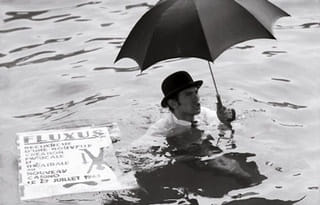
The Proto-Fluxus period of development culminated in seven Fluxus festivals which were held in different European cities in 1962 and 1963. Certain pieces were performed multiple times at different festivals and these included Drip Music by George Brecht in which a source of dripping water was placed above an empty vessel and Nivea Cream Piece by Alison Knowles, where multiple performers covered their hands with Nivea cream and rubbed them together in front of a microphone.
These festivals were definitive in that they brought the performance aspects of Fluxus to the fore. As art historian Hannah Higgins notes, “the Event performance typically consists of simple, everyday actions such as viewing a chance occurrence through a keyhole or polishing a violin … In the event, everyday actions are framed as minimalistic performances or, occasionally, as imaginary and impossible experiments with everyday situations.” The festivals also garnered significant media attention, which brought the movement to wider public notice and gained traction for its ideas amongst other artists.
With greater attention focused on the movement, new artists such as Nam June Paik and Joseph Beuys joined in 1962. Paik had met key members of Fluxus whilst studying in West Germany in the late-1950s, but initially experimented with new video technologies in Japan before joining the group and then moving to New York in 1964. He is considered to be the founder of Video art. Beuys was a colleague of Paik in Germany and an artist and educator. He believed that the study of art should be open to all, stating that, “teaching is my greatest work of art…the rest is the waste product, a demonstration. If you want to express yourself you must present something tangible. But after a while this has only the function of a historic document. Objects aren't very important any more. I want to get to the origin of matter, to the thought behind it.” These beliefs were reflected in the performance art that he created.
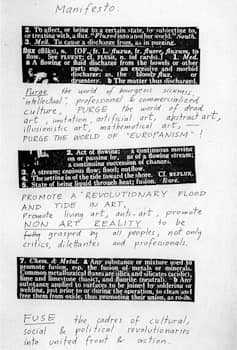
The group resumed activities in New York and between 1963 and 1965, they held a number of concerts and festivals in and around the city. As the self-proclaimed leader of the group, George Maciunas had strong opinions that he frequently and forcefully expressed. This often led to contention between himself and other Fluxus artists. Maciunas articulated his beliefs in a number of Fluxus manifestos, the first of which was published in 1963. In it, he stated that he wanted to “purge the world of… ‘intellectual‘, professional & commercialized culture, purge the world of dead art, imitation, artificial art, abstract art, illusionistic art, mathematical art”. Other Fluxus artists such as Jackson Mac Low, however, did not agree, writing that, "I would not want to eliminate museums (I like museums)".
Maciunas was also volatile, using his disagreements with members to indiscriminately expel them from the Fluxus group. In 1963, Maciunas removed Mac Low, and the following year, expelled Dick Higgins, Alison Knowles, and Nam June Paik. The artists, however, did not take these excommunications very seriously, with Knowles recording that, “Oh, yes, we were excommunicated. But you have to understand the personality of this man was very strange and wonderful and we never took the excommunications that hard at all”. Despite these, usually temporary, exclusions, Fluxus was, on the whole, an inclusive movement, as Fluxus artist Mieko Shiomi remembered, “First of all, the best thing about Fluxus, I think, is that there was no discrimination on the basis of nationality and gender. Fluxus was open to anyone who shared similar thoughts about art and life. That’s why women artists could be so active without feeling any frustration.”
In 1966, Maciunas and Ken Friedman launched “Fluxus West”, setting up new Fluxus centers in San Francisco and San Diego. As part of this project, Friedman purchased a bus to take Fluxus even further afield. This was dubbed the “Fluxmobile” and it traveled extensively throughout the United States, with Friedman noting that, “Fluxus West brought various forms of Fluxus exhibitions, events, performances, and workshops to 40 of the 50 United States and to 3 of the Canadian provinces … By the fall of 1967, a regular pattern of Fluxmobile trips up and down the West Coast became established which continued through the early ’70s, alternating with occasional long excursions to inland areas or to the MidWest or East Coast.”
Fluxus: Concepts, Styles, and Trends
Performance and Participation
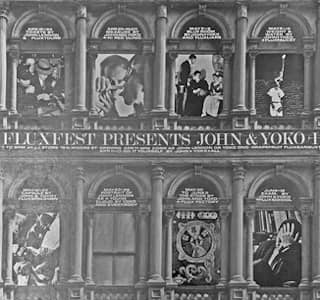
Performance held a central role in the Fluxus movement and was the most utilized form of expression for those associated with the group. It offered artists a way to reject established artistic hierarchies and practices and incorporate elements of chance into their work. Fluxus performances often involved interactive elements, encouraging individuals to engage with the art on a personal and immediate level and blurring distinctions between performer and observer, challenging the passive role typically assigned to the audience. This involvement also made artworks unpredictable as audiences could react in different ways. This emphasis on participation not only democratized the artistic experience but also reflected Fluxus's broader commitment to anti-authoritarianism. For example, in the 1970 Fluxfest Presentation of John & Yoko, Maciunas made paper masks of John Lennon and Yoko Ono for the audience to wear. The use of the audience as the focus of the piece was a logical extension of his idea that, "anything can substitute for art and anyone can do it...the value of art-amusement must be lowered by making it unlimited, mass-produced, obtainable by all and eventually produced by all."
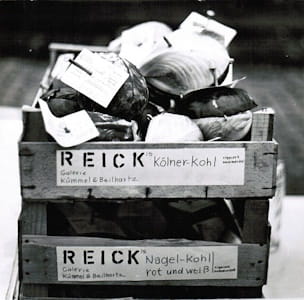
Although Fluxus is mainly known for performances and events, Fluxus artists also created more tangible forms of art, such as boxes filled with various items (often called Fluxkits), prints, and Fluxus films. Some of these physical objects, however, still contained pieces of performance. For example, Dieter Reick's Cologne Cabbage consisted of a crate of cabbages, where one half of a red cabbage and one half of a white cabbage had been nailed together. The cabbages were later offered for sale at the weekly market in Cologne-Braunsfeld, adding performative and interactive elements to the artwork.
Zen Approach
Zen is a Japanese Buddhist philosophy that focuses on meditation and the importance of the present moment. No single moment is to be more important than another in life. Zen had a powerful impact on John Cage and he drew directly on Buddhist teachings, stating that art should be “important as a means to make one aware of one's actual environment."
Some Fluxus artists sought to apply the Zen philosophy to art, seeking to reach a kind of enlightened state where art and life would meld into one with no distinction between them. In artist Emmett Williams’s autobiography, My Life in Flux and Vice Versa published in 1992, he notes, in a very Fluxus fashion, that “ultimately, there is only one way out of the Fluxus-Zen dilemma: the art of zenzen. Zenzen allows you to have it both ways. It teaches us that Fluxus is totally involved with Zen, Fluxus is entirely involved with Zen, Fluxus is quite involved with Zen, Fluxus is completely involved with Zen, and, even more important, Fluxus is not at all involved with Zen.” Although Maciunas once stated that Fluxus was, "more like Zen than Dada." Maciunas himself was less concerned with the Zen aspect of things and more concerned with a political, nonsensical, and anti-art stance.
Examples of Zen beliefs and practices in Fluxus art include John Cage’s composition 4'33 which consisted of a pianist sitting at a piano without playing, allowing ambient sounds to become the music. This reflects the Zen concept of appreciating silence and finding beauty in everyday sounds. Similarly, Maciunas’ Solo for Violin and La Monte Young's Composition 1960 #7 involved the creation of simple and continuous sounds, in the case of the former, a single violin note, and the latter, the notes B3 and F#4, with the instruction that they should be "held for a long Time". These highlight the Zen ideals of sustained attention and the meditative quality of sound. Ideas of Zen mindfulness were also incorporated by artists such as Nam June Paik, who explored the meditative aspect of breathing in some of his work, and Yoko Ono, whose instructions for her piece Grapefruit encouraged readers to engage in simple yet mindful activities and to foster awareness of their surroundings and experiences.
Humor
Humor played a role in many Fluxus works, employing wit and absurdity to engage viewers. Through doing this, the movement rejected the seriousness and elitism often associated with traditional art, opting instead for a lighthearted and irreverent exploration of everyday life. The incorporation of humor within Fluxus, not only, made art more accessible but also encouraged a participatory and democratic approach to creativity, emphasizing the joyous and unpredictable nature of artistic expression. This approach was often used by Ben Vautier, whose Fluxus Finger (1963), for instance, involved presenting his middle finger to the audience.
Expressions of Sexuality
A number of Fluxus artists incorporated overt elements of sensuality and sexual exploration into their performances. These artists challenged traditional taboos surrounding sexuality, using provocative and, sometimes, controversial imagery to disrupt established norms. Fluxus works often transcended conventional boundaries, exploring the intersection of the personal and the political in matters of sexuality. By incorporating sexual themes, Fluxus contributed to the broader cultural dialogue around liberation, identity, and the reevaluation of societal constraints.
Amongst the most controversial of these performances were Meat Joy (1964) by Carolee Schneemann, where performers, in skimpy underwear, writhed about the stage in a sexual manner while interacting with meat including raw fish, chickens and sausages, and Vagina Painting (1965) by Shigeko Kubota, who used a brush placed in her vagina to create paintings, blurring the boundaries between the artist's body and the canvas and exploring themes of intimacy. This area of Fluxus was led by the female members of the movement, making a Feminist statement in the process. It was not, however, entirely confined to them, with other members such as Ben Vautier and Benjamin Patterson also incorporating sex and sexual references into their work.
Later Developments - After Fluxus

Fluxus arguably came to an end with the death of Maciunas in 1978. A "Fluxfuneral" was held, as requested by Maciunas, and this was put together by Geoffrey Hendricks and included the performances of several Fluxus artists. Afterwards there was a "Fluxfeast and Wake", where all the food was black, white or purple. This was the last major Fluxus event, although smaller episodes are occasionally held, even today.
Fluxus's radical approach and rejection of traditional artistic conventions served as a catalyst for innovation and experimentation in later art movements. Performance art and Happenings, which prioritize live actions and audience engagement, drew inspiration from Fluxus' emphasis on the performative and the incorporation of everyday actions into artistic practice. And, the movement’s emphasis on ideas and concepts over material objects helped to pave the way for Conceptual art. The influence of Fluxus also resonates within later incarnations of Performance art, Land art, and Graffiti and Street art, and with those artists who deliberately work outside established museum systems.
Useful Resources on Fluxus
- Fluxus: The History of an AttitudeOur PickBy Owen F. Smith
- The Fluxus ReaderOur PickBy Ken Friedman (editor)
- Fluxus: Selections from the Gilbert and Lila Silverman Collection, Museum of Modern Art, New YorkBy Clive Phillpot, Jon Hendricks and George Maciunas
- Fluxus ExperienceOur PickBy Hannah Higgins
- Mr. Fluxus: A Collective Portrait of George MaciunasBy Ann Noel and Emmett Williams (editors)
- Japan FluxusBy Luciana Galliano
- A Flexible History of Fluxus Facts & FictionsBy Emmett Williams
 Ask The Art Story AI
Ask The Art Story AI